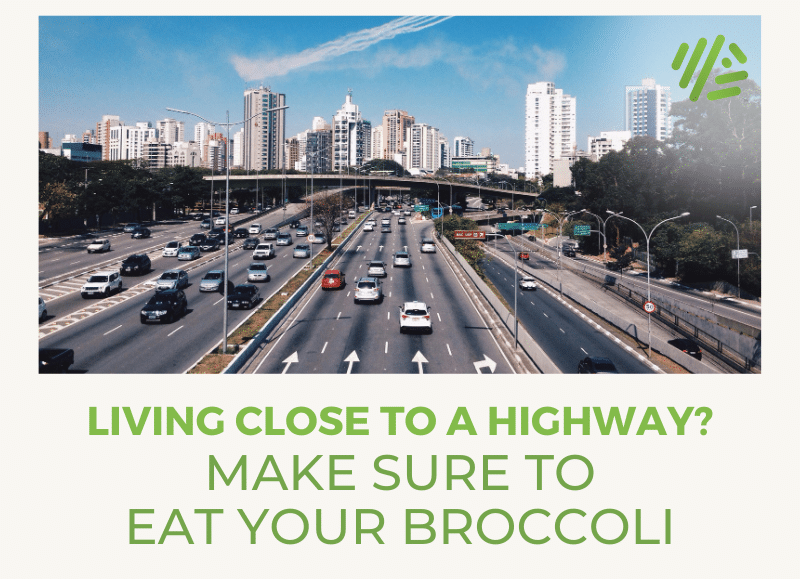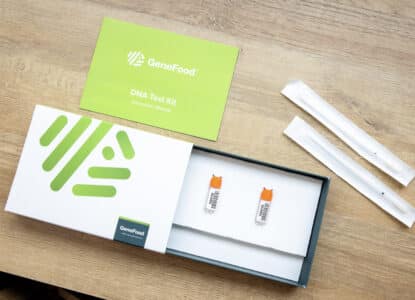Can Eating Broccoli Help Detoxify From Air Pollution?
Genes Mentioned

Contents
If you’ve spent much time in Southern California, and especially Los Angeles, you see a surprising amount of residential development built right next to the highway.
For example, The Orsini, containing over 1,000 units within a stone’s throw of the 101 and 110 Highways. According to the LA Times, one-bedroom units at The Orsini can rent for as much as $2,500 per month.
For a brief three month stint while living in downtown San Diego a few years ago, I stayed at 1810 State Street, a building marketed as “upscale” but located just 150 feet from the 5 Freeway, one of the busiest sections of freeway in Southern California. These highway adjacent buildings are sometimes more “affordable” than similar buildings located further from the highway, but they carry with them a health burden.
According to the CDC website:
In the United States, it is widely accepted that economically disadvantaged and minority populations share a disproportionate burden of air pollution exposure and risk.
The closer you live to a highway, generally, the worse off for your health, and it’s often minority and underrepresented communities that disproportionately occupy these dwellings. This blog is going to show you how to identify the problem, and if you can’t move right away, offer a simple nutrition tip that could help until you can find alternative housing.
The body has built in detox pathways
First, let me introduce a nerdy topic – Nrf2. I promise you’ll find some value if you follow a long. Here at Gene Food, we are a little obsessed with the NrF2 pathway, a genetic transcription factor responsible for “turning on” over 200 genes, many of which are related to detoxification.
- As we’ve written about previously, nutrition can play a role in activating NrF2.
- Because of a compound known as sulforaphane, broccoli sprouts are one of the best NrF2 activators, which is presumably why a growing number of studies have linked consumption of cruciferous vegetables to a reduction in cancer risk.
- Benzene is a volatile organic compound, or “VOC,” that is the byproduct of both cigarette smoke and, you guessed it, automobile exhaust.
- If you’re living close to a highway, specifically within 500-1,000 feet, you are coming in contact with higher levels of benzene, as well as other dangerous VOCs.
- Sulforaphane, the compound found in broccoli sprouts acts as a cancer chemopreventive agent. For example, this study, which found that sulforaphane inhibited the carcinogenic effect of benzene. It seems that sulforaphane, by triggering NrF2, helps to turn on genes like GSTP1, which in turn help the body make glutathione, the master detoxifier, which sticks to and removes heavy metals and other bad stuff from our system.
The negative health effects of living within 500 feet of a freeway
In fact, the state of California, in conjunction with scientists at UCLA have recommended that the Golden State stop developers from building schools or residential buildings within 500 feet of a highway as proximity over extended periods of time has been linked to increased risk for a host of diseases, including heart disease, stroke, lung cancer, and dementia. 1 For example, this study which measured the blood of people living in close proximity to a highway found that inflammatory markers like C-reactive protein and IL-6 were higher in populations that lived next to a freeway, and therefore their risk for heart disease was higher.
Our results suggest that highway proximity affects blood markers of inflammation which are, in turn, associated with increased cardiovascular disease risk.
The LA Times has published a tool for Californians that allows them to measure how close their building is to the nearest freeway. As mentioned above, the 500-1,000 foot range is classified as the “pollution zone,” and it is remarkable how many buildings, many of them “fancy” new developments, fall within the range that is considered unsafe.
Pollution zone: San Diego’s Little Italy neighborhood
For example, a large percentage of San Diego’s nicest downtown neighborhood, Little Italy, is within 1,000 feet of Highway 5, a massive traffic artery that carries hundreds of thousands of cars every day.
I measured a new residential building in San Diego’s Little Italy, named after its address at 1810 State Street, to see how close it was to the nearest freeway. The result: 350 feet! To make matters worse, there is an Elementary School directly across the street. The marketing material for 1810 State says the building is “inspired by SoHo, Chelsea, and the High Line” in New York City, but no disclosures are made about proximity to the highway, and to my knowledge, the building does not have a special air filtration system set up to handle all the pollution.
What about the West Side Highway in Manhattan?
In some sense, the High Line tie in makes sense, as the High Line is adjacent to the West Side Highway, not a major interstate in the traditional sense, but the LA Times tool cautions that “living in close proximity to a road that gets in excess of 100,000 vehicles per day poses a similar health risk to living near a freeway.” I looked it up, and parts of the West Side Highway get more than 100,000 vehicles per day. 2 Ok, so let’s take this post in a more optimistic direction. Especially if you’re within 500 feet of a highway, or a road that gets in excess of 100,000 vehicles per day, it is best to move. However, what if you can’t? Or what if you live just outside of the pollution zone and are looking for ways to use food to help your body detox?
The broccoli air pollution study

This brings us back to NrF2.
There is a study out there which looked at broccoli’s ability to detoxify contaminants from air pollution specifically.
In a randomized 12 week clinical trial in China, participants were given a “broccoli sprout derived beverage,” with glucoraphanin, a sulforaphane precursor. The subjects lived in an area of China that has problems with air pollution (for those of you have have visited China, you know it is a wonderful place, but air pollution is a huge issue). The group receiving the broccoli sprout beverage excreted much more benzene, presumably because of increased glutathione production. To quote the study:
Rapid and sustained, statistically significant (P ≤ 0.01) increases in the levels of excretion of the glutathione-derived conjugates of benzene (61%), acrolein (23%), but not crotonaldehyde, were found in those receiving broccoli sprout beverage compared with placebo.
Pretty impressive. The study authors concluded that eating broccoli sprouts was a “frugal” way of aiding the detoxification of air pollution. So, there you have it. If you live close to a highway, it’s time for the broccoli sprouts, friends, and maybe a good air purifier. That is until you get the chance to move.




Hey,
Just read your Brokkoli-detox article and loved it. It just shows the power of activating Nrf2. Luckily that’s what my work is focused on.
If I showed you something that is proven to be more effective in activating Nrf2 would you take a look?
Would love to connect with you.
Regards from Ireland
Brian